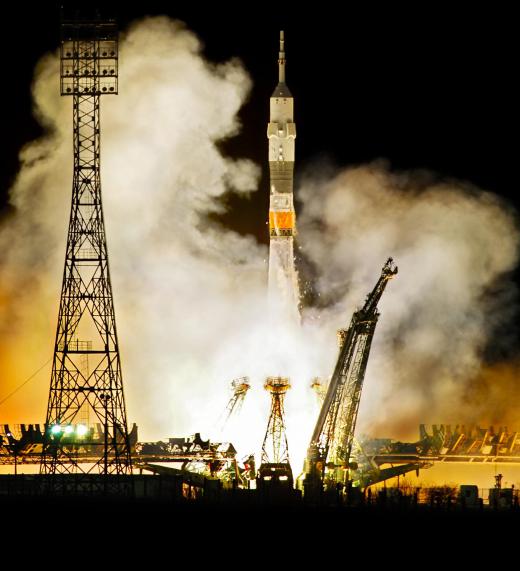What is a Scramjet?
 Michael Anissimov
Michael Anissimov
Conventional rockets create thrust by combining liquid fuel with an oxidizer, usually liquid oxygen. Both the fuel and the oxidizer take up a lot of space, resulting in rockets that must be very large to achieve the thrust necessary to launch a satellite into orbit. For example, 8 grams of oxygen is necessary to ignite 1 gram of hydrogen, a typical rocket fuel. For a rocket to hold both a fuel and oxidizer requires containers for both, further increasing the total weight of the rocket and requiring an even greater amount of fuel to lift a given payload into orbit. Conventional rockets need a complex network of pipes and holes to ensure that the fuel and oxidizer mix evenly and quickly throughout the launch process.
Moving beyond the techniques employed by conventional rockets, the scramjet (Supersonic Combustion Ramjet) uses atmospheric oxygen as an oxidizer, bypassing the need for an onboard oxidizer completely. A large scoop at the front of the craft takes in air, while onboard systems isolate oxygen from the air, compress it, and introduce it to a stream of fuel when then uses the oxygen to combust and produce thrust. For a scramjet to intake sufficient oxygen for self-sustaining flight, it must already be moving at supersonic speeds. For this reason, a scramjet must be coupled to a conventional rocket at the beginning of its flight.

The first successful scramjet trial occurred on 16 August 2002 when the University of Queensland's HyShot team launched their scramjet rocket from a launch pad in Woomera, Australia. Mounted on a Terrior Orion rocket, the scramjet achieved speeds of Mach 7.7 and flew for a total of 6 seconds, enough to demonstrate that the scramjet principle works. NASA has expressed great interest in scramjet technology, launching the Hyper-X program, a collaborative effort between Langley Research Center in Hampton, Va. and Dryden Flight Research Center in Edwards, Calif., for the purpose of making scramjet technology a practical reality.

One day, scramjets could take passengers from Tokyo to New York City in under 2 hours, almost 10 times faster than conventional airliners. Because a scramjet carries no oxidizer tanks, it can be much lighter, faster, and ultimately cheaper than conventional rocket technology. Its only exhaust is water, released from combining hydrogen, the fuel, with oxygen, the oxidizer, and it needn't discard massive empty tanks as conventional rockets do. The scramjet might be the most appropriate tool for taking payloads and passengers up into orbit in a future era of commercialized spaceflight.
AS FEATURED ON:
AS FEATURED ON:












Discussion Comments
wow simply awesome new york to tokyo under 3 hours. i would love to fly in the future jets. really, i'm amazed at the level of research going on and thanx to the author of this article for clearly explaining. thank you.
Responding to anon 30763 and 30738
I have had the privilege of having met and talked many times with Dr. Paull of Queensland University the pioneer and developer of the scram jet engine.
I have seen first hand many shock tunnel tests at the laboratory where this work was carried out over many years.
In regard to the questions regarding stalling in outer space and spare oxygen reserves, both are valid points and the explanation follows:
First the scramjet aerospace plane is said in some estimates to be capable of up to Mach 25 in the rarest atmosphere. At even mach 7 or 8 though the aerospacecraft engine is capable of taking on board atmospheric oxygen in adequate quantities.
However there are two good reasons for having on board liquid oxygen reserves: These are why:
One: In the event the aerospaceplane slips beyond the atmosphere and the jet stalls then it and its occupants would be lost forever to space. It would be essential and necessary to reattain ignition by closing off the intake and injecting a stream of oxygen from the reserves ala a conventional rocket engine scenario. In space it would also be necessary to have directional thrusters as well as the main engine thrust in order to maintain directional stability and the ability to return to Earth.
However this now raises my second point through the posing of a question to which the answer is as follows: Why not now allow the craft to become a space craft? With sufficient on board oxygen this craft could easily complete a flight to the moon and back. This is because in space there is no resistance to motion. Hence the craft could achieve unlimited speeds with only occasional thrust bursts from the main engine. It could land its passengers and payload on the moon and then return to earth. Once back in the atmosphere at supersonic speeds the intake is opened and the scramjet engine reactivated as normal.
Some other points of interest now arise for me to convey and these are:
1. It does not necessarily need a rocket booster engine at take off for the scramjet to be ready for ignition. Potentially high enough speeds will be able to be achieved just with the use of a military standard turbojet engine. So this aircraft could fly to space in the most efficient and natural way.
Thoughts of conventional flight to space came about because of the fact that enormous reserves of fuel and oxygen are necessary to literally "fight" gravity for the likes of the space shuttle to get to space. The new technology means that the scramjet powered Hyperjet will most likely become the leader as the new space shuttle option. Instead of huge reserves needed to fight gravity, the scram shuttle will do it so easily just by conventional flight.
Finally the barrier to all of this happening is not the scramjet engine itself. It is already in advanced development and could be ready for military and commercial uses any time from now on.
However the stumbling block at this time is the new barrier to flight. First we had to overcome aircraft failures due to the sound barrier. Today it is not an issue. However the next barrier is. It is the heat barrier. It is the very reason today's high performance military aircraft are unlikely to exceed Mach 3 for some time to come. The heat barrier I understand kicks in with full grunt at around Mach 5. Simply the aircraft will overheat and burn to a cinder using current day materials and technology. So we are now at the forefront of a new development era and evolution in flight both in the atmosphere and in space. New materials have to be developed so that the scram jet Aerospace plane and Space Shuttles can go fast enough to become viable for both military and commercial use.
The days of these barriers to progress are numbered however. And as long as man does not destroy himself through a nuclear holocaust, then our everyday flight a hundred or two years form now will be truly awesome and spectacular. Beyond then the mind boggles at what manner of transportation will be common 500 to 1000 years from now.
The Scramjet is a development that will help make those futures possible to become reality in the centuries to come.
Author: "Magna" - wjc
Wouldn't the engine stall after it left the atmosphere due to a lack of oxygen in space? I fail to see how this would work as a spacecraft.
This is exciting technology, but supersonic is not that fast, could not the scramjet, in a sort of hybrid mode using a small amount of liquid oxygen, reach supersonic speeds on its own then switch to oxygen intake at those speeds for fuel?
Post your comments